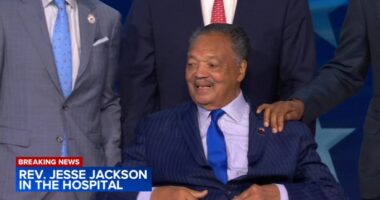Share this @internewscast.com

In a previous column, I talked about Elon Musk’s intention to start a new political party. This initiative seems unlikely to succeed because Musk aims to replace the Republicans, and his primary focus—reducing government spending—has long been part of the Republican agenda.
But that column got me thinking – is there a potential opening for a new political party in our two-party system?
I believe there is. All indications are that the Democrat Party is in big trouble.
Let’s reflect on American political history. Traditionally, the United States has had two major, broad-based coalition parties that compete nationwide. Throughout our history, two such parties have faded away: the Federalists and the Whigs.
How and why did this happen?
The Federalists
The Federalist Party, mainly rooted in New England, was led by Alexander Hamilton. Their philosophy leaned towards “big government,” although at the time this meant advocating for limited national enhancements such as constructing new waterways and roads, imposing certain federal taxes (excluding income taxes), forming a military, establishing banks, and supporting tariffs. Known as the party of educated elites, the Federalists were often dismissive of common workers and farmers. Consequently, their rivals, the Democratic-Republicans, frequently portrayed them as monarchists.
The Federalists fell apart because: 1) they had weak and fratricidal leadership; 2) no control over the federal government from 1801 on, and thus, no patronage; 3) focused on elite opinion and were disdainful of the common man; and 4) were promoting policies that the (expanded) voter pool was simply not buying. Part of their problem was that the first President, George Washington, was basically a Federalist, but he refused to join them to stay non-partisan. When he left office, John Adams, who was a party member, became president. But Adams was not the Federalist leader, and he and Hamilton famously did not get along.
In fact, Hamilton tried to defeat Adams in 1796, and as a result, put Thomas Jefferson, the leader of the Democratic-Republicans, in the Vice Presidency. In 1800, Jefferson swept Adams out of office, the Federalists lost their majorities in Congress (which they would never win back), and just four years later, Hamilton was killed in a duel.
For the remainder of their time in existence, the Federalists had no strong leadership, and in the 1812 election, a Democratic-Republican named Dewitt Clinton, the mayor of New York City, took advantage of Federalist weakness by winning the endorsement of the party, despite not being a member (a la Bernie Sanders). Clinton ran with an ambiguous position on the War of 1812; the Federalist party was strongly against that war. But he failed to win the electoral college or even the popular vote. With General Andrew Jackson’s later victory in that war, the Federalist Party was derided as a party of cowards and ceased to exist after 1816.
The Whigs
When Andrew Jackson, as a presidential candidate and then as a president, created his Democrat Party, his opponents fell into their own party coalition to oppose him (eventually): the Whig Party. The Whigs were a very loose combination, which sometimes had party segments that joined and then left, in rapid succession, which often tried to avoid being pinned down on the issues because of its conflicting factions. When in office, it tended to promote the “American System”, which was a “big government” ideology like that of the Federalist Party.
Its main leader was Henry Clay, who, despite his constant scheming for it, never won the presidency. The Whigs fell apart for essentially the same reasons as the Federalists, because: 1) they had weak and fratricidal leadership; 2) little control over the federal government, and thus, little patronage; 3) were heavily focused on avoiding issues and catering to the elites; and 4) were promoting policies that the (expanded) voter pool was simply not buying.
There were a total of four Whig presidencies; however, only over eight years. And it got worse for the Whigs – when William Henry Harrison died, his successor, John Tyler, was a WINO (Whig In Name Only) who had largely identical beliefs to Southern Democrats but had joined the Whigs because of his opposition to Andrew Jackson personally. As president, Tyler was expelled by the Whigs for refusing to implement the American System, appointed Democrats to his administration, and even made a play for the Democrat Party presidential nomination.
Meanwhile, later, in 1848, Whig nominee Zachary Taylor won the presidency with a plurality because a former Democrat president ran as a third-party antislavery candidate. Taylor won while his party lost their House majority and failed to carry the Senate. He died less than 2 years later, with Vice President Millard Fillmore succeeding to that office. Fillmore backed the “Compromise of 1850” legislation that attempted to paper over the nation’s divisions on slavery, which divided his own party, and prevented him from winning the Whig presidential nomination (as the sitting president) in 1852.
The Whigs rarely controlled Congress during their 22 years in existence – only managing four years each of leadership over the Senate and the House.
It is well-known by historians that the issue of slavery was what finally ended the Whig coalition. Both the Whigs and the Democrats had Southern and Northern wings, which had opposing views on slavery. Of the two, the Southern Democrats were more viscerally pro-slavery; the Southern Whigs largely tried a “me-too” strategy, where they attempted to keep that issue off the table and focus on promoting their American System, which was more popular with their elites.
So, when slavery became the burning issue in the 1850s, the Southern Democrats refused to abandon it, essentially taking control of their party, and the antislavery people in both parties spun off to create a new party that was exclusively opposed to slavery, the Republicans. And the Whigs fell apart.
Today’s Democrat Party seems to be following in the footsteps of the Federalist and Whig Parties.
To be continued in Part 2…

















